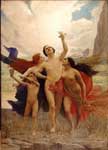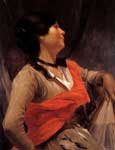Paintings

Bandit

Child Reading

Coquetería

Penitent Magdalene

The Merchant's Pearl

Nymph with Cherries

Youth tempted by the vices

Child with a Fez

Girl with yellow dress

Seville Woman

Nude Man
Alfredo Valenzuela Puelma (8 February 1856 Valparaíso, Chile, –27 October 1909 Villejuif, France )
Alfredo Valenzuela Puelma (Valparaiso, Chile, February 8, 1856 - Villejuif, France, October 27, 1909) was a Chilean painter, the first to paint nudes in the country.1 Member of the generation of "Great Masters of painting Chilean "with Pedro Lira, Juan Francisco González and Alberto Valenzuela Llanos, within four is considered best represents the formal perfection, based on the prevailing art in época.2
Biography
Puelma Valenzuela was born in Valparaiso, the art historian Richard Bindis relates in his book "Painting Chile 200 years" that the child was from small skilled draftsman. According to him, began painting Puelma from an early age and at age ten and had painted his first painting with brushes made by himself.
He studied at the Academy of Painting in Santiago as a disciple of Kirchbach Ernesto and Giovanni Alfredo Valenzuela Mochi.1 Puelma was not getting good reviews, preferred to improve personally as he said the same author. Morally, Puelma called himself anticlerical, strongly agree with the era of secular laws and reforms of the liberal republic. Manifested in newspapers and literary reviews public controversial views, liked to read paragraphs from the Bible and quote it in its examples. Since childhood he learned to play the piano, which kept him busy and became their second choice of work for which he composed several songs, however, finally choose the paint.
"Nymph of cherries" is one of the most renowned works of the painter, winner of multiple awards, now in the Pinacoteca of the University of Concepcion in the Great room teachers.3
His skills quickly earned him accolades not only from their own colleagues, but also of their teachers. Pedro Lira, however, was the young painter and upset. Puelma apparently never wanted to have teaching roles at the Museum of Fine Arts, but, interested in personal growth, strongly fought by a grant to take him to Paris.
The pearl merchant (1884). One of the fascinations of Puelma was the Eastern world and its exotic lands. The painting "The Pearl of the merchant" is an example of this where you can see pictorial taste Orientalist romanticism. The work is now in the Museo Nacional de Bellas Artes de Chile.
Finally in 1881 managed to get a scholarship which allowed him to travel to France. There he continued his studies under the teachings of Benjamin Constant, who taught him to improve his technique. Before returning to Chile in 1885, Valenzuela Puelma advantage of museums where he saw works by painters such as Titian, Murillo, Rembrandt and Velázquez.4 May 6
In Chile he worked with the painter Pedro Lira, however poverty and madness that afflicted did intractable, so we both entered a deep artistic rivalry that would accompany them all their life. Eusebio Lillo, author of the national anthem of Chile, helped Puelma in economic misery and got him a pension decree signed by the then President Balmaceda. As a result the teacher was able to paint his second masterpiece, The nymph of the cherries. This win honorable mention in the prestigious Parisian atmosphere and then a third medal in Madrid a year siguiente.7
"The lesson of geography." The painter maintains very strict rules of the academy for much of his life, many historians cite it as the apex of the formal model in Chile, but why not leave Puelma everyday issues as may apreciarce in "The lesson of geography "8
Valenzuela then took care Puelma improve their artistic skills to be a portrait, landscape and the nude specialty. In a way his portraits became his main source of income and began to design more out of obligation. His technique came to be world class and winning awards at various European festivals. In Chile, his art is censored and criticized by the poses of their naked (which he pioneered) which earned him scathing attacks on his paintings. Anyway receives major awards in his country such as the first medal at the official Salon of Santiago, 1877, first and second prize at the official Salon of Santiago in 1878, first medal at the Exhibition City of Valparaiso in 1896, among other .
In 1887 he again received a scholarship to study in Paris, this time in the workshop of Jean Paul Laurens, where he remained until 1890.4 Back in his native country, was named Marcos Maturana in 1892.6
While in Paris, the writer Augusto d'Halmar shared with the artist, noting the economic and psychological suffering:
"I agreed with him in this friendly and unforgettable Paris in 1908 and realized that the reason the artist was foundering and would soon anegarle madness [...] At the same time failed disimularme their misery, and I even noticed for it rested that had only a pile of newspapers' .9
Puelma Valenzuela died on October 27, 1909 in a psychiatric hospital in Villejuif. Although his funeral was held in France, his remains were repatriated and honored at the National Museum of Fine Arts in his country natal.10
Remember the painter's art historian Ricardo Bindis that:
"His dexterity has no competitors in the Chilean painting, either by the silky and light touch, for the drawing that surprised by the foreshortening made and the fluidity of the line, which ran with unparalleled ease
Add to that Ana Francisca Allamand:
"The scenes of Valenzuela Puelma are balanced and each object is perfectly located, while upholding the central figures. However, it was known that the artist was concerned with such details as much as the main characters. Proof of this is the perfection of its flowers, books and furniture
[Edit] Influence and perception of his work
Statue at the General Cemetery of Santiago.
The painter specializing in the human figure and portraits, the first Chilean to make paintings of nudes, which earned him praise abroad and harsh criticism in the country.5 The main influence on his work were realistic paintings Spanish artists he saw while in Francia.10 His style is part of the current academicista.5
His work was not well received in Chile, having a greater prominence in countries Europe.4 This hostile reception in his native country, where he received criticism from other artists and even family-made it was considered as a misunderstood artist. Still, his work influenced the so-called generation of 1913.11 12
His works include The nymph of cherries, The Pearl of the merchant, fezzes's Child, geography lesson and my son Rafael.13
His works are exhibited in major museums such as Chile's House of Art in Design, Museum of Fine Arts in Chile, O'Higgins Historical Museum, the National History Museum, among others.
Awards and honors
The Little Admiral.
1877 - First Medal, Officer Hall, Santiago, Chile.
1878 - First and Second Medal, Officer Hall, Santiago, Chile.
1880 - First Medal, Officer Hall, Santiago, Chile.
1884 - First Medal, Officer Hall, Santiago, Chile.
1889 - Honorable Mention, Paris Salon, France.
1890 - Third Medal, Autumn Exhibition, Madrid, Spain.
1892 - Contest General Marcos Maturana, Official Salon, Santiago, Chile.
1892 - Edwards Award Competition, Official Salon, Santiago, Chile.
1896 - First Medal, Exhibition City of Valparaiso, Chile.
1899 - Edwards Award Competition, Official Salon, Santiago, Chile.
1901 - Third Medal, Exhibition of Buffalo, USA.
1903 - Competition Edwards, Official Salon, Santiago, Chile.
1930 - Third Medal, International Exhibition of Seville, Spain.
Literature
Origo editions, ed (2008). Alfredo Valenzuela Puelma (first edition). Santiago: Origo editions. Retrieved April 11, 2011.
Bindis, Ricardo (2006). Chilean painting, two hundred years. Santiago: Origo Ediciones.
Romera, Antonio (1976) (PDF). History of Chilean painting. Santiago: Andrés Bello. Retrieved April 11, 2011.
References
↑ a b Encyclopedia of Chile. 4. Spain: Grupo Editorial Ocean. pp. 950-951. ISBN 84-494-1079-7.
↑ "Generation masters of Chilean painting." Portaldearte.cl. Retrieved on January 26, 2009.
↑ "Gallery of the University of Conception." Retrieved on March 22, 2011.
↑ a b c "Life of Alfred Valenzuela Puelma." Portaldearte.cl. Retrieved on January 30, 2009.
↑ abc "Alfredo Valenzuela Puelma (1856-1909)." University of Chile. Retrieved on January 26, 2009.
↑ a b Romera, Antonio R. (1976). History of Chilean painting. Santiago: Andrés Bello. pp. 87.
↑ http://www.portaldearte.cl/obras/nincere.htm
↑ The geography lesson, Chilean Memory
↑ Halmar d'Augusto (June 1938) (pdf). A Chilean gets.
↑ a b "Alfredo Valenzuela Puelma." Chilean Artists. Retrieved May 17, 2009.
↑ Armendariz, Maite (May 3, 2009). "Valenzuela Puelma bare." The Mercury. Retrieved on May 6, 2009.
↑ Marin, Graciela Espinoza, Denisse (May 3, 2009). "From crazy misunderstood to master: 100 Years of Puelma Valenzuela." The Third. Retrieved on May 6, 2009.
↑ "I am a child, Children in art history." Retrieved on March 22, 2011.
From Wikipedia. Text is available under the Creative Commons Attribution-ShareAlike License
